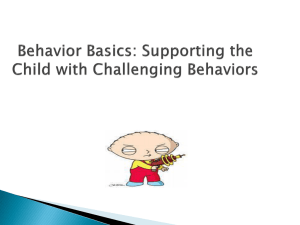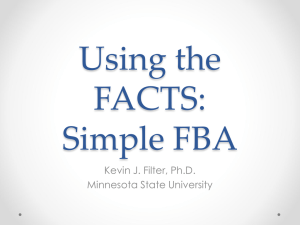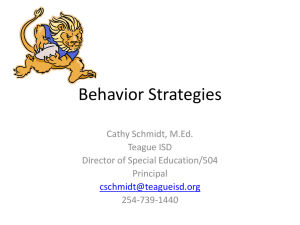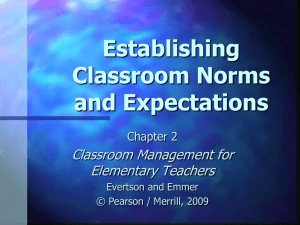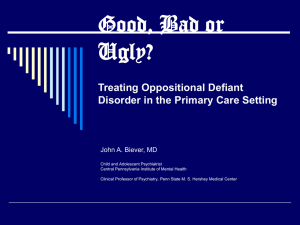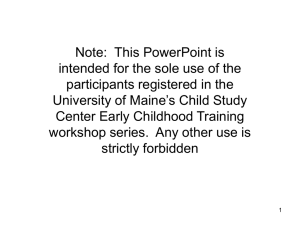Behavior presentation - Perth Amboy Public Schools
advertisement
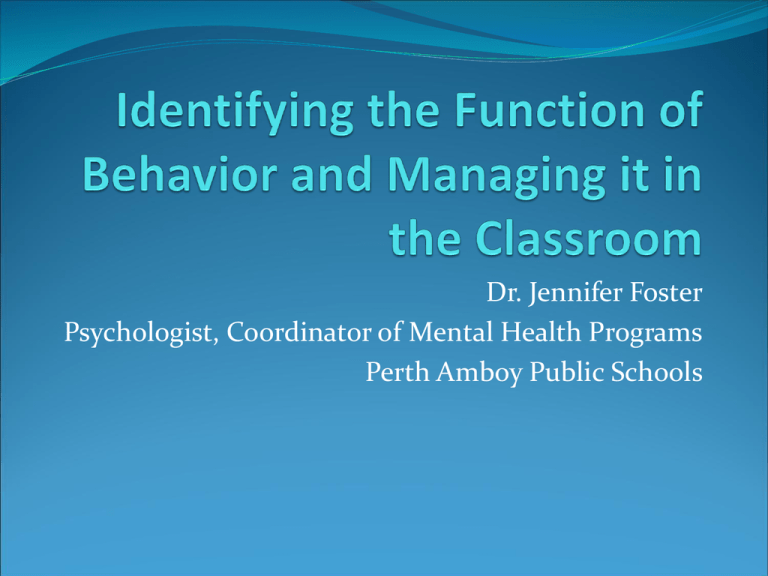
Dr. Jennifer Foster Psychologist, Coordinator of Mental Health Programs Perth Amboy Public Schools Agenda Brief Overview of Disruptive Behavior Disorders Oppositional Defiant Disorders Conduct Disorders (Early & Late Onset) Disruptive Behavior Disorders (NOS) ABC’s of Behavior Functions of Behavior Management of Acute and Chronic Behavioral Problems CPI Crisis Development Model District Referral Process What is a Disruptive Behavior Disorder? Attention-Deficit Disorders and Disruptive Behavior Disorders are the two categories considered under “Disruptive Behavior Disorder” Disruptive Behavior Disorders are broken down into to 3 major categories of mental health disorders Oppositional Defiant Disorder Conduct Disorder (Early & Late Onset) Disruptive Behavior Disorder (NOS) Oppositional Defiant Disorder (ODD) Diagnostic Criteria A persistent pattern of defiant, angry, antagonistic, hostile, irritable, or vindictive behavior Most often directed toward authority figures Pattern of behavior must be present for 6 months Extremely difficult to manage due to confrontational nature Behavior must be causing significant problems, in school and in relationships with family and friends ODD Diagnostic Criteria Must have 4 of 8 symptoms occurring frequently Loses temper Argues with adults Actively defies or refuses to comply with adult’s requests or rules Deliberately annoys people Blames others for own mistakes or misbehavior Touchy and easily annoyed by others Angry and resentful Spiteful of vindictive ODD Signs & Symptoms Stubborn and noncompliant Contentious and argumentative Quick to shift blame Highly Defensive See demands as unreasonable Passive aggressive/systematically ignore others Refusal to negotiate Deliberate annoyance of others Threatens/intimidates others Verbally aggressive Present with low self-concept or inflated self-esteem Oppositional Defiant Disorder Average age of onset is 6 years old, symptoms can be seen in children as early as 3 years old Symptoms usually manifests by 8 years old, with most children diagnosed during preadolesence Early onset of ODD is more likely to persist and lead to subsequent development of CD More prevalent in males than females prior to puberty, but evens out in adolescence Comorbid with: CD, learning disabilities, ADHD, depression, anxiety 80%+ with ODD have comorbid ADHD 65% with ADHD have comorbid ODD Criteria for Conduct Disorder (CD) A repetitive and persistent pattern of behavior that involves violation of age appropriate social norms and the rights of others Four categories of aggressive behaviors and violations of rules and age appropriate norms Aggression toward people and animals Destruction of property Deceitfulness or theft Serious violations of rules Criteria for CD (Cont.) At least 3 of the 15 items, present for 12 months Of which one symptom in the past 6 months Significant impairment in social, academic, or occupational functioning Differences in age of onset Early Childhood Onset—onset of at least one criterion characteristic of CD prior to age 10 Outcomes are poor, ingrained behavior is highly resistant Adolescence Onset—absence of any criteria characteristic prior to the age of 10 More resilient b/c they developed better coping skills at earlier age Signs & Symptoms of CD Aggressive behavior that harms or threatens other people or animals (i.e., physical altercations, intimidation, bullying) Destructive behavior that damages or destroys property Manipulation via lying, deceit Theft Truancy or other serious violations of rules Early tobacco, alcohol, and substance use and abuse Precocious sexual activity Show little remorse for their actions, empathy, or concern for the thought or feelings of others Read hostile intent in the actions of others, reactive Fake feelings to get lesser consequence, seek to blame others Disruptive Behavior Disorder Not Otherwise Specified (DBD NOS) This category of DBD was created for children who demonstrate similar behaviors as children with ODD or CD but do not display the same frequency /severity and only met one or two of the behavior criteria for this disorder. Like ODD and CD, this disorder causes significant impairment in the child’s life. ABC’s of Behavior Antecedent Behavior Consequence The Dance of Behavior Antecedent Behavior Consequence Teacher giving lesson Child raises hand Teacher continues with lesson Teacher continues with lesson Child calls out Teacher asks child to quiet down Teacher asks child to quiet down Child keeps talking Teacher moves onto another activity, singing and dancing, and asks the class to stand up Teacher moves onto another activity, singing and dancing, and asks the class to stand up Child refuses to stand up Teacher asks child to stand up Teacher asks child to stand up Child refuses and remains seated on the floor Teacher walks over to child and tries to physically pick him up Teacher walks over to child and tries to physically pick him up Child becomes weightless as teacher tries to lift him Teacher whispers, “Either I can pick you up like mommies pick up their little babies or you can stand up on your own,” in his ear. Teacher continues with activity Child stands up Teacher whispers, “Either I can pick you up like mommies pick up their little babies or you can stand up on your own,” in his ear. Teacher continues with activity Child is cooperating and enjoying himself The song and dance ends and teacher says, “okay, now we are going to sing the color song” Antecedent Behavior Consequence The song and dance ends and teacher says, “okay, now we are going to sing the color song” Child calls out “I win, I win, I win” Teacher asks children to sit down on the floor Teacher asks children to sit down on the floor Child sits down Teacher passes out colored blocks Teacher passes out colored blocks Child calls out “I want orange, I want orange” Teacher gives the child an Orange block Teacher gives the child an Orange block Child is happy and shows his blocks to his friend Teacher realizes that the color orange is not in the song and asks the child for the block back Teacher realizes that the color orange is not in the song and asks the child for the block back Child puts block behind his back and says “no” Teacher tries to grab the block out of child’s hand Teacher tries to grab the block out of child’s hand Child holds on to the block tight and tries to pull it away from the teacher Teacher tells child there is no orange in the song, and tries to give him a blue block instead Teacher tells child there is no orange in the song, and tries to give him a blue block instead Child refuses to give her the orange Teacher tells child that he can keep block the orange block on the floor next to him, but he has to use the blue block Child puts the orange block by his Teacher begins song with children side on the floor and takes the blue block Teacher tells child that he can keep the orange block on the floor next to him, but he has to use the blue block Functional Analysis Determining the function of the behavior The process of gathering information to determine the relations between variables, particularly functional relations Looking to answer the question “What is the function of the behavior?” A functional relationship exists when a cause and effect relationship between variables has been experimentally established Trying to find what contingencies maintain the behavior Can be environmental Can be “internal” environmental effects Must “listen” or observe behavior to determine causes! Primary Functions of Behavior Escape/Avoidance: from person, task, environment, etc. behavior usually occurs in response to specific person, event or requests to perform activity. Tangible: desire for a specific item or activity behavior often occurs when something has been denied or taken away -- it is not person or event specific Attention (positive or negative): desire for attention from peers, adults, can include “power” behaviors usually occurs when specific individuals are present -may be all the time if the desire is for attention from peers -- it is person specific -- not event or location. Sensory: the behavior feels good or meets a sensory need. behaviors occur anytime, anywhere--not person, event or location specific but may occur more often when under stress Functions of Behavior Behaviors may result from a combination of function Escape and sensory are often related to circumstances that are stressful or boring Attention and escape may result from difficult/boring curricular demands and not much attention Tangible in combination with any of the others may be a result of boredom. Combinations of 2 or more functions require a careful look at curricular requirements, basic classroom management, and availability of noncontingent reinforcement. Questions To Be Answered. . . 1. 2. 3. 4. 5. What are the setting events (i.e., conditions that alter the probability of a behavior occurring What are the antecedents of the challenging behavior (i.e., specific events that precede a behavior)? What are the consequences for the challenging behavior, which may reinforce it? What does the student gain? What does the student avoid? 19 When Samantha misses her 12:30 medication & teachers present multiple task demands, she makes negative self-statements & writes profane language on her assignments. Teaching staff typically send her to the office with a discipline referral for being disrespectful. What function? Avoid difficult tasks Setting event Misses 12:30 medication Antecedent Response Consequence Teachers make multiple task demands Semantha makes negative selfstatements & writes profane language Teacher sends Samantha to office for being disrespectful Caesar has dyed his hair three colors & is teased several times by his friends before class. When he enters the class, his teacher stares at his hair. Caesar immediately says “what are you staring at?” His teacher immediately sends him to inschool detention. Escape adult & What peer function? attention Setting event Caesar is teased several times about his hair by his friends before class Antecedent Response Consequence His teacher stares at his hair in class Caesar asks his teacher what she’s staring at His teacher sends him to in-school detention Cleo is new to the 6th grade, & English is her second language. When another student approaches & says something to her in English, Cleo turns away. The other student walks away. This happens several times during the day. Whatpeer function? Escape attention Setting event Antecedent New student Student approaches & speaks in English Response Cleo turns away Consequence Other student walks away When his teacher asks him what the capitol city of a country is, Napoleon gives the correct answers. His teacher praises his correct answer, & tells him he may work by himself or a friend on the rest of the assignment. Access peer & adultfunction? attention What Setting event Antecedent Response None Teacher asks what capitol city of country is Napoleon give correct answer Consequence Teacher gives verbal praise & time to work with a friend As Manny is walking, other kids look at him & say “what’s up?” He looks back and says: “Who ya lookin’ at?!” “Ya want some of this?!” “Ya talkin’ to me?!” Kids shake their heads & call him “weirdo.” Access peer attention What function? Setting event ?? Antecedent Response Look at him. “What’s up!” “Who ya lookin’ at?” “Ya want Some?” “Ya talkin’ to me? Consequence Kids shake heads & call him “weirdo” Describing the Problem Behavior? 1. 2. 3. 4. 5. Note the type of problem behavior Note where the problem behavior occurs Note when the problem behavior occurs Note characteristics of the setting and events related to the problem behavior Note situations or personal events that might induce the behavior 6. 7. include actions of others that increase or trigger the behavior. Note the consequences associated with the problem behavior. Once this is understood, you can test a hypothesis 25 Developing/Testing a Hypothesis Develop a hypothesis based on the information gathered Test the Hypothesis—Experimentally evaluating precisely whether the antecedents and consequences that may control behavior, actually do. Testing the hypothesis is important because important information may have been overlooked during data collection Intended to reveal what is likely to be an effective intervention before moving to the intervention stage Example of hypothesis statement When he misses breakfast & peers tease him about his walk, Caesar calls them names & hits them. Teasing stops. Hypothesis Statement Setting Events Triggering Antecedents Problem Behavior Misses breakfast. Teased by peers. Name calling & Hits. Maintaining Consequences Teasing stops. Function Function Once you have a have a hypothesis, you can experiment with interventions Escape negative Escape social contact aversive social contact The Conflict Cycle Crisis Development Model (CPI, 2005) Crisis Development/Behavior Levels Anxiety Defensive Acting Out-Person Tension Reduction Staff Attitudes/Approaches Supportive Directive Non-Violent Physical Crisis Intervention (last resort) Therapeutic Rapport INTEGRATED EXPERIENCE: The concept that behaviors and attitudes of staff impact the behaviors and attitudes of those in their care Proactive Approaches Maintain sufficient personal space Awareness of non-verbal cues from body language It’s not what you say, but how you say it Set Limits Empathetic Listening When Responding… Do Don’t Remain Calm Overreact Isolate the Situation Get into power struggles Enforce Limits Make false promises Listen Fake attention Be aware of Non-Verbal cues Be threatening Be consistent Use jargon—tends to confuse and frustrate Effective Environments Problem behaviors are irrelevant Aversive events are removed Access to positive events are more common Problem behaviors are inefficient Appropriate behavioral alternatives available Appropriate behavioral alternatives are taught Problem behaviors are ineffective Problem behaviors are not rewarded District Behavioral Referral Process Speak to your student’s Child Study Team Case Manager and/or Crisis Counselor to determine if a referral is warranted. Children diagnosed with Autism are an automatic referral. If the student sees a Crisis Counselor, the referral is submitted by the student’s Crisis Counselor If there is no Crisis Counselor assigned, then the case manager should complete the form Once submitted & reviewed, a behavioral consultant will be assigned to the case and contact the Crisis Counselor/Case Manager Initial observations will be conducted A meeting will be coordinated with the consultant/crisis counselor and/or case manager, and teacher Recommendations will be made. This may or may not include the decision to conduct a functional behavioral assessment and develop a behavior plan. Case follow-up will continue throughout the process. Questions?? Contact Information Dr. Jennifer Foster Psychologist, Coordinator of Mental Health Programs Office: Department of Special Services/Administration Building Email: jennfoster@paps.net (best way to contact) Phone: 732-376-6200 Ext. 30234 Fax: 732-826-4932


